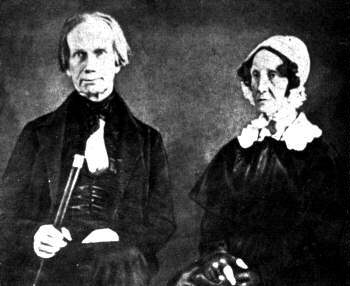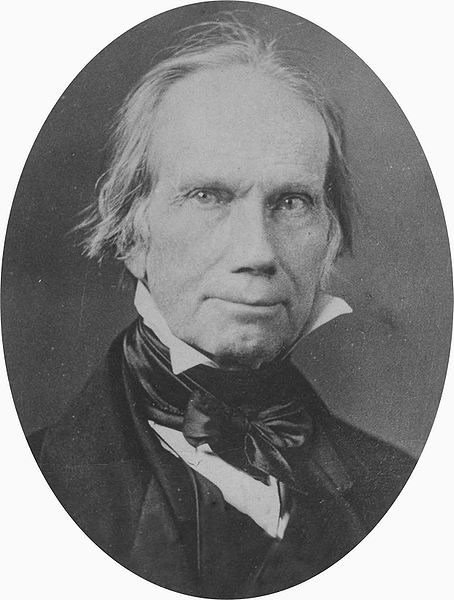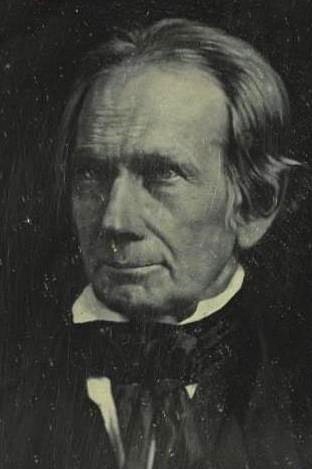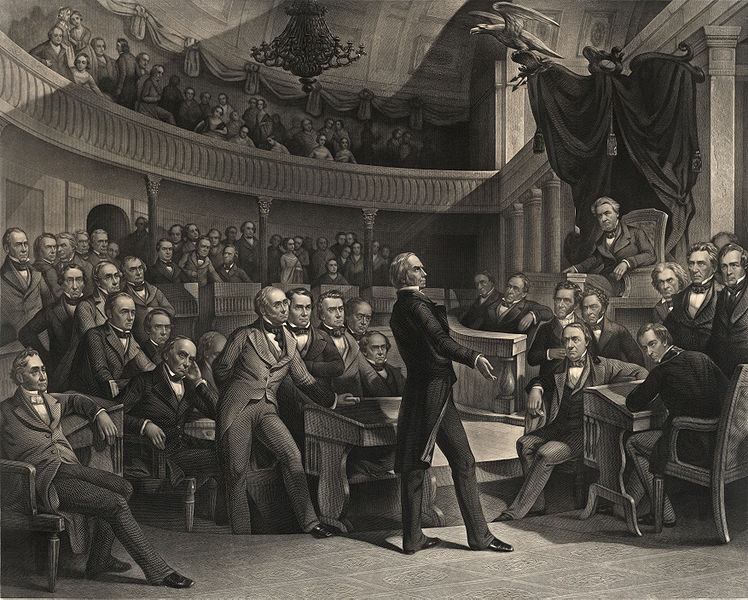<Back to Index>
- Mathematician Germinal Pierre Dandelin, 1794
- Playwright Aleksandr Nikolayevich Ostrovsky, 1823
- Secretary of State Henry Clay, Sr., 1777
PAGE SPONSOR
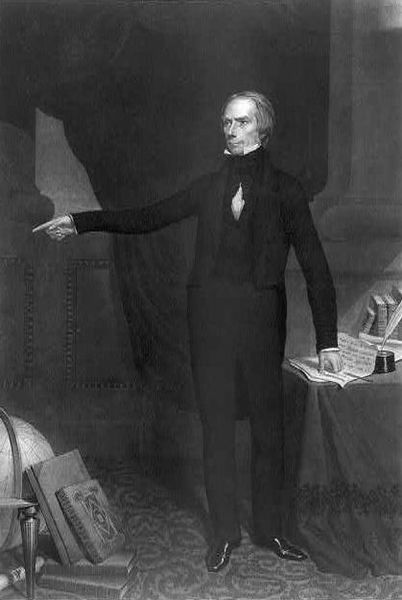
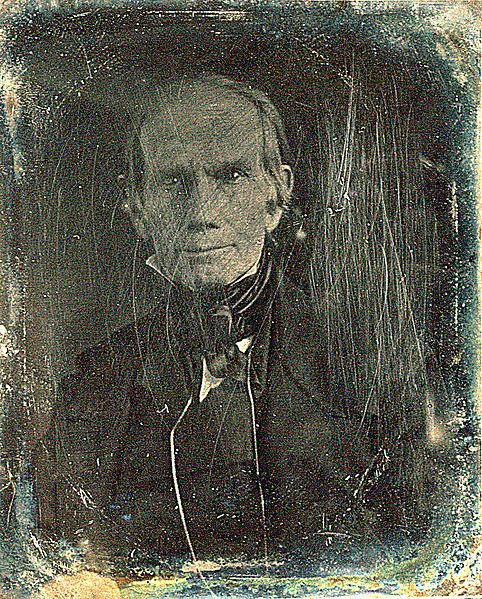
Henry Clay, Sr. (April 12, 1777 – June 29, 1852), was a nineteenth century American statesman and orator who represented Kentucky in both the Senate and the House of Representatives, where he served as Speaker. He also served as Secretary of State from 1825 to 1829.
He was a dominant figure in both the First and Second Party Systems. As a leading war hawk, he favored war with Britain and played a significant role in leading the nation to war in 1812. He was the foremost proponent of the American System,
fighting for an increase in tariffs to foster industry in the United
States, the use of federal funding to build and maintain
infrastructure, and a strong national bank. He opposed the annexation
of Texas, fearing it would inject the slavery issue into politics. Clay
also opposed the Mexican - American War and the "Manifest Destiny"
policy of Democrats, which cost him votes in the close 1844 election.
Dubbed the "Great Compromiser," he brokered important compromises
during the Nullification Crisis and on the slavery issue, especially in 1820 and 1850, during which he was part of the "Great Triumvirate" or "Immortal Trio," along with his colleagues Daniel Webster and John C. Calhoun.
He was viewed as the primary representative of Western interests in
this group, and was given the names "Henry of the West" and "The
Western Star." In 1957, a Senate committee chaired by Sen. John F. Kennedy named Clay as one of the five greatest Senators in U.S. history. Abraham Lincoln,
Whig leader in Illinois, was a great admirer of Clay, saying he was "my
beau ideal of a great man." Lincoln wholeheartedly supported Clay's
economic programs. Henry Clay was born on April 12, 1777, at the Clay homestead in Hanover County, Virginia, in a story-and-a-half frame house, an above average home for a Virginia farmer of that time. He was the seventh of nine children of the Reverend John Clay and Elizabeth Hudson Clay. His father, a Baptist minister called "Sir John," died four years later (1781). He left Henry and his brothers two slaves each and his wife eighteen slaves and 464 acres (1.88 km2) of land. She soon married Capt. Henry Watkins, who proved himself to be an affectionate stepfather to Clay. He moved the family to Richmond, Virginia, where Elizabeth had seven children with Watkins to add to the nine she had with John Clay.
In Richmond, Clay was hired as a shop assistant. His stepfather later secured Clay employment in the office of the Court of Chancery, where he displayed an adeptness for understanding the intricacies of law. There he became friends with George Wythe, who was hampered by a crippled hand and chose Clay to be his secretary because of his neat handwriting. While Clay was employed as Wythe's amanuensis, the chancellor took an active interest in Clay's future and arranged a position for him with the Virginia attorney general, Robert Brooke. Clay received a formal legal education at the College of William and Mary in Virginia, studying under George Wythe. Under Brooke, Clay prepared for the bar, to which he was admitted in 1797.
On April 11, 1799, Clay married Lucretia Hart at the Hart home in Lexington, Kentucky. She was a sister to Captain Nathaniel G. T. Hart, who died in the Massacre of the River Raisin in the War of 1812. Clay
and his wife had eleven children (six daughters and five sons):
Henrietta (1800 – 1801), Theodore (1802 – 1870), Thomas (1803 – 1871), Susan
(1805 – 1825), Anne (1807 – 1835), Lucretia (1809 – 1823), Henry, Jr. (1811 – 1847), Eliza (1813 – 1825), Laura (October 1815 - 1817), James Brown (1817 – 1864), and John (1821 – 1887). Seven of Clay's children preceded him in death. By 1835 all six daughters had died of varying causes from whooping cough to yellow fever to complications of childbirth, and Henry Clay Jr. was killed at the Battle of Buena Vista during the Mexican - American War.
His wife Lucretia died in 1864 at the age of 83 and is interred with
her husband in the vault of his monument at the Lexington Cemetery.
Clay was a second cousin of emancipationist Cassius Marcellus Clay and the great-grandfather of suffragette Madeline McDowell Breckinridge.
Seeking to establish a lucrative law practice, Clay relocated in November 1797 to Lexington, Kentucky, near where his family then resided in Woodford County. He soon established a reputation for his legal skills and courtroom oratory. Some of his clients paid him with horses and with land. Clay came to own town lots and the Kentucky Hotel. By 1812, Clay owned a lucrative 600-acre (240 ha) plantation dubbed "Ashland." One
of Clay's clients was his father-in-law, Colonel Thomas Hart, who was
an early settler of Kentucky and a prominent businessman. Clay's most famous client, however, was Aaron Burr in 1806 when United States District Attorney Joseph Hamilton Daviess indicted him for planning an expedition into Spanish Territory west of the Mississippi River. Clay and his partner, John Allen, successfully defended Burr. Some years later Thomas Jefferson convinced Clay that Daviess had been right. Clay was so upset by this that many
years later when he met Burr again, Clay refused to shake his hand.
In 1803 Clay was elected to serve as the representative of Fayette County in the Kentucky General Assembly.
As a legislator, Clay advocated a liberal interpretation of the state's
constitution and initially the gradual emancipation of slavery in
Kentucky, although the political realities of the time forced him to
abandon that position. Clay also advocated moving the state capitol from Frankfort to Lexington. He defended the Kentucky Insurance Company, which he saved from an attempt in 1804 by Felix Grundy to repeal its monopolistic charter. Clay's influence in Kentucky state politics was great enough for him to be elected by the Kentucky legislature for the Senate seat to which John Breckinridge had initially been elected; Breckinridge resigned to become Attorney General of the United States, and at first John Adair was chosen to complete Breckinridge's term, but Adair had to resign his seat for his alleged part in the Burr Conspiracy. Clay became a Senator on December 29, 1806 and served for less than one year. Clay was below the constitutionally appointed age of thirty when
elected. However, this age discrepancy apparently was not noticed by
any other Senator, and perhaps not even by Clay himself. Three months and seventeen days into his Senate service, he reached the age of eligibility. Such a thing has happened to only two other U.S. Senators.
When he returned home in 1807, he was elected the Speaker of the Kentucky House of Representatives. On
January 3, 1809, Clay introduced to the Kentucky General Assembly a
resolution requiring members to wear homespun suits rather than British broadcloth. Only two members voted against the patriotic measure. One of them was Humphrey Marshall, an "aristocratic lawyer who possessed a sarcastic tongue," who had been hostile toward Clay in 1806 during the trial of Aaron Burr. Clay and Marshall nearly came to blows on the Assembly floor and Clay challenged Marshall to a duel. The duel took place on January 9 in Shippingport, Indiana. They each had three turns. Clay grazed Marshall once, just below the chest. Marshall hit Clay once in the thigh.
In 1810, United States Senator Buckner Thruston resigned to serve as a judge on the United States Circuit Court and Clay was again appointed to fill his seat. In the summer of 1811 Clay was elected to the United States House of Representatives. He was chosen Speaker of the House on the first day of his first session, something never done before or
since. During the fourteen years following his first election, he was re-elected five times to the House and to the speakership. Before
Clay's entrance into the House, the position of Speaker had been that
of a rule enforcer and mediator. Clay turned the speakership into a
position of power second only to the President of the United States. He
immediately appointed members of the War Hawk faction (of which he was the "guiding spirit")
to all the important committees, effectively giving him control of the
House, quite a maneuver for a 34-year-old House freshman. The War
Hawks, mostly from the South and the West, resented British violation
of U.S. maritime rights and treatment of U.S. sailors. They advocated
for a declaration of war against the British. As the Congressional leader of the Democratic - Republican Party, Clay took charge of the agenda, especially as a "War Hawk", supporting the War of 1812 with the British Empire. Later, as one of the peace commissioners, Clay helped negotiate the Treaty of Ghent and signed it on December 24, 1814. In
1815, while still in Europe, he helped negotiate a commerce treaty with
Great Britain. Also during his early House service, he strongly opposed
the creation of a National Bank,
in part because of his personal ownership in several small banks in his
hometown of Lexington. Later he changed his position and gave strong
support for the Second National Bank when he was seeking the presidency. Henry Clay helped establish and became president of the American Colonization Society, a group that wanted to send freed African American slaves to Africa and that founded Monrovia in Liberia for
that purpose. On the amalgamation of the black and white races, Clay
said that "The God of Nature, by the differences of color and physical
constitution, has decreed against it." Clay presided at the founding meeting of the ACS on December 21, 1816, at the Davis Hotel in Washington, D.C. Attendees also included Robert Finley, James Monroe, Bushrod Washington, Andrew Jackson, Francis Scott Key, and Daniel Webster. Henry Clay and John C. Calhoun helped to pass the Tariff of 1816 as part of the national economic plan Clay called "The American System," rooted in Alexander Hamilton's American School. Described later by Friedrich List,
it was designed to allow the fledgling American manufacturing sector,
largely centered on the eastern seaboard, to compete with British
manufacturing through the creation of tariffs. After
the conclusion of the War of 1812, British factories were overwhelming
American ports with inexpensive goods. To persuade voters in the
western states to support the tariff, Clay advocated federal government
support for internal improvements to infrastructure, principally roads
and canals. These internal improvements would be financed by the tariff
and by sale of the public lands, prices for which would be kept high to
generate revenue. Finally, a national bank would stabilize the currency
and serve as the nexus of a truly national financial system. Clay's
American System ran into strong opposition from President Jackson's
administration. One of the most important points of contention between
the two men was over the Maysville Road.
Jackson vetoed a bill which would authorize federal funding for a
project to construct a road linking Lexington and the Ohio River, the
entirety of which would be in the state of Kentucky, because he felt
that it did not constitute interstate commerce, as specified in the Commerce Clause of the United States Constitution.
In foreign policy, Clay was the leading American supporter of independence movements and revolutions in Latin America after 1817. Between 1821 and 1826, the U.S. recognized all the new countries, except Uruguay (whose
independence was debated and recognized only later). When in 1826 the
U.S. was invited to attend the Columbia Conference of new nations,
opposition emerged, and the American delegation never arrived. Clay
supported the Greek independence revolutionaries in 1824 who wished to separate from the Ottoman Empire, an early move into European affairs.
In
1820 a dispute erupted over the extension of slavery in Missouri
Territory. Clay helped settle this dispute by gaining Congressional approval for a plan called the "Missouri Compromise". It brought in Maine as a free state and Missouri as
a slave state (thus maintaining the balance in the Senate, which had
included 11 free and 11 slave states), and it forbade slavery north of
36º 30' (the northern boundary of Arkansas) except in Missouri.
By 1824, the unparalleled success of the Democratic - Republican Party had
driven all other parties from the field. Thus, there were four major
candidates seeking the office of president, one of whom was Clay.
Because of the unusually large number of candidates, no candidate
secured a majority and the tie between the two front runners, Andrew Jackson and John Quincy Adams, was broken in the House of Representatives, where Clay used his
political clout to secure the victory for Adams, whom he felt would be
both more sympathetic to Clay's political views and more likely to
appoint Clay to a cabinet position. When Clay was appointed Secretary of State, his maneuver was called a "corrupt bargain" by many of Jackson's supporters and tarnished Clay's reputation. After the passage of the Tariff of 1828,
dubbed the "tariff of abominations" which raised tariffs considerably
in an attempt to protect fledgling factories built under previous
tariff legislation, South Carolina declared its right to nullify federal tariff legislation and stopped assessing the tariff on imports. It threatened to secede from
the Union if the Federal government tried to enforce the tariff laws.
Furious, President Jackson threatened to lead an army to South Carolina
and hang any man who refused to obey the law. The crisis worsened until 1833 when Clay, again a U.S. Senator re-elected by Kentucky in
1831, helped to broker a deal in Congress to lower the tariff
gradually. This measure helped to preserve the supremacy of the Federal
government over the states, but the crisis was indicative of the
developing conflict between the northern and southern United States
over economics and slavery. During Clay's congressional and Secretary of State terms, he lived on Lafayette Square in Washington, DC, originally called the President's Park, in the house originally built for Stephen Decatur. When Clay relocated to Washington from Kentucky, he brought with him slaves Aaron and Charlotte Dupuy to
work in his household, as well as their two children Charles and Mary
Ann. Living there for nearly two decades, they enjoyed the relative
freedoms of urban life as part of a community of blacks, both enslaved and free, in the city. As
Clay was preparing to leave Washington to return to Kentucky in 1829,
Charlotte Dupuy had an attorney file a lawsuit in district court for
her freedom. Her legal challenge to slavery preceded the more famous Dred Scott case by 17 years. Unlike the latter, it never reached the US Supreme Court.
Dupuy accused Henry Clay of wrongful enslavement and demanded freedom
for her and her children, based on a promise of freedom by her previous
owner James Condon. Many details of the case are unknown, but there is
evidence that the case received a fair amount of attention in the
press. It lasted quite a while, and the court ordered that Charlotte
Dupuy remain in DC until the case was settled. Clay returned to his
plantation in Lexington with Aaron, Charles and Mary Ann Dupuy. The
Court ruled against Dupuy, arguing that any agreement with Condon did
not bear on her next owner. Because she refused to return voluntarily
to Kentucky, Clay had his agent arrest her. Dupuy was imprisoned in Alexandria, Virginia, before Clay arranged for her transport to New Orleans,
where he placed her with his daughter and son-in-law Martin Duralde.
She worked there for another decade. Her daughter was sent to join her
there. Dupuy's case has not been well known. The Decatur House Museum
now has a permanent exhibit on urban slavery and Dupuy's legal
challenge of her powerful master. Restored areas of the house museum
include the kitchen, where Dupuy would most likely have worked. In
1840 Henry Clay finally gave Charlotte and her daughter Mary Ann Dupuy
their freedom in New Orleans. He kept Charles Dupuy with him as a
servant during his speaking engagements, frequently citing him as an
example of how well he treated his slaves. Clay granted Charles Dupuy
his freedom in 1844. After the election of Andrew Jackson, Clay led the opposition to Jackson's policies. Those in Clay's camp included the National Republicans who
were beginning to refer to themselves as "Whigs" in honor of their
ancestors during the Revolutionary War, who opposed the tyranny of King George III just as they opposed the "tyranny" of Jackson. Clay strongly opposed Jackson's failure to renew the charter of the Second Bank of the United States, advocating the passage of a resolution to censure Jackson for his actions. In 1832 Clay was unanimously nominated for the presidency by the National Republicans; Jackson, by the Democrats.
The main issue was the policy of continuing the Second Bank of the
United States. Clay lost by a wide margin to the highly popular Jackson (55% to 37%). In 1840, Clay was a candidate for the Whig nomination, but he was defeated in the party convention by supporters of war hero William Henry Harrison.
Harrison was chosen because his war record was attractive and he was
seen as more electable than Clay. If the Whigs had been more aware of
the political weakness of President Martin Van Buren, they would have probably selected Clay.
In 1844, Clay was nominated by the Whigs against James K. Polk, the Democratic candidate. Clay lost due in part to national sentiment for Polk's "54º40' or Fight" campaign, which was to settle the northern boundary of the United States with Canada, then under the control of the British Empire. Clay opposed admitting Texas as a state because he believed it would reawaken the slavery issue and provoke Mexico to
declare war. Polk took the opposite view, supported by most of the
public, especially in the Southern United States. Nevertheless, the
election was close; New York's 36 electoral votes proved the difference, and went to Polk by a slim 5,000 vote margin. Liberty Party candidate James G. Birney won
a little over 15,000 votes in New York and may have taken votes from
Clay. Eventually, Clay's warnings came true. The US annexation of Texas
led to the Mexican - American War (1846 – 1848), while the North and South came to increased tensions during Polk's Presidency over the extension of slavery into Texas and beyond. After
losing the Whig Party nomination to Zachary Taylor in 1848, Clay
decided to retire to his Ashland estate in Kentucky. Retired for less
than a year, he was in 1849 again elected to the U.S. Senate from
Kentucky. During his term, the controversy over the expansion of
slavery in new lands had reemerged with the addition of the lands ceded
to the United States by Mexico in the Treaty of Guadalupe Hidalgo at the conclusion of the Mexican - American War. David Wilmot,
a Northern congressman, had proposed preventing the extension of
slavery into any of the new territory in a proposal referred to as the "Wilmot Proviso". On
January 29, 1850, Clay proposed a series of resolutions that he saw as
amenable to both Northern and Southern viewpoints in what would widely
be called the Compromise of 1850.
Originally intended by Clay to be voted on separately, at the urging of
southerners Clay agreed to the creation of a Committee of Thirteen to
consider the measures. The committee was formed on April 17, and on May
8 Clay, the chairman of the committee, presented an Omnibus bill
linking all of the resolutions to the Senate floor. These resolutions included: The
Omnibus bill, despite Clay's efforts, failed in a crucial vote on July
31 with the majority of his Whig Party opposed. He announced on the
Senate floor the next day that he intended to persevere and pass each
individual part of the bill. Clay, however, was physically exhausted as
the effects of the tuberculosis that would eventually kill him began to take its toll. Clay left the Senate to recuperate in Newport, Rhode Island, while Stephen A. Douglas wrote the separate bills and guided them through the Senate. Clay
was still given much of the credit for the Compromise's success. It
quieted the controversy between Northerners and Southerners over the
expansion of slavery and delayed secession and civil war for another
decade. Senator Henry S. Foote of
Mississippi, who had suggested the creation of the Committee of
Thirteen, later said, "Had there been one such man in the Congress of
the United States as Henry Clay in 1860-'61 there would, I feel sure,
have been no civil war." Clay continued to serve both the Union he loved and his home state of Kentucky until June 29, 1852, when he died of tuberculosis in Washington, D.C., at the age of 75. Clay was the first person to lie in state in the United States Capitol. He was buried in Lexington Cemetery, and the eulogy was provided by Theodore Frelinghuysen, who ran as Clay's vice-presidential candidate in the election of 1844. Clay's headstone reads simply: "I know no North — no South — no East — no West." The 1852 novel Life at the South; or, "Uncle Tom's Cabin" As It Is by W.L.G. Smith is dedicated to Clay's memory. Ashland,
named for the many ash trees on the property, was his plantation and
mansion for many years. He owned as many as 60 slaves at once. It was
there he introduced the Hereford livestock breed to the United States. Rebuilt
and remodeled by his heirs, Ashland is now a museum. The museum
includes 17 acres (6.9 ha) of the original estate grounds and is
located on Richmond Road (US 25)
in Lexington. It is open to the public (admission charged). For several
years (1866 – 1878), the mansion was used as a residence for the regent
of Kentucky University, forerunner of the University of Kentucky and present day Transylvania University. Henry Clay is credited with introducing the mint julep drink to Washington, D.C., at the Willard Hotel during his residence as a senator in the city.
